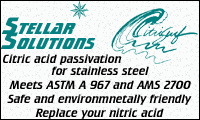
-----
How to get shiny finish on 304 after passivating in nitric acid
We make bolts of grade 304ss. after passivating in Nitric Acid we get dull finish. then they are electropolished. we need some chemical formula to get back the glossy finish.
Prachir Gupta- Aligarh, UP, India
2006
It sounds like you are etching your stainless. Make up a small sample in the lab using lab grade acids and distilled water. Passivate a few parts. I doubt if they will loose much of their luster. Chlorides from a previous tank or from your water could cause the problem.
James Watts- Navarre, Florida
2006
Dulling during passivation may result from a high dissolved iron content or a low nitric content. What are your solution's values?
Ken Vlach [deceased]- Goleta, California
Rest in peace, Ken. Thank you for your hard work which the finishing world, and we at finishing.com, continue to benefit from.
2006
Its useless to passivate first, then Electropolish because the electropolish process eats through way past any pre-existing passivation layer. And electropolish process itself provides fine, and often superior passivation. You can find Auger & Esca data demonstrating this for well run processes with a google search. Often you will find Nitric or citric acid final passivation at the end of an electropolish sequence. But I've usually found the e-polish surface to be inert to the acids at that point, indicating the part is already fully passivated.

Dave Kinghorn
Chemical Engineer
SUNNYvale, California
2006
citric acid passivation will not etch the surface or change the finish like nitric acid does. As was previously mentioned, passivation should be performed after electropolishing, not before.

Ray Kremer
Stellar Solutions, Inc.
McHenry, Illinois

2006
this text gets replaced with bannerText

Q, A, or Comment on THIS thread -or- Start a NEW Thread